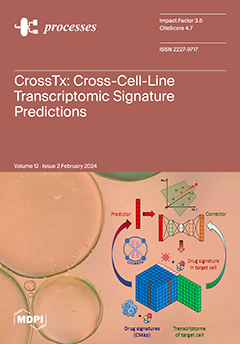The increased concentration of CO
2 in the atmosphere has a strong impact on global warming. Therefore, efficient technologies must be used to reduce CO
2 emissions. One of the methods is the biofixation of CO
2 by microalgae and cyanobacteria. This is
[...] Read more.
The increased concentration of CO
2 in the atmosphere has a strong impact on global warming. Therefore, efficient technologies must be used to reduce CO
2 emissions. One of the methods is the biofixation of CO
2 by microalgae and cyanobacteria. This is now a widely described technology that can improve the economics of biomass production and reduce CO
2 emissions. There are no reports on the possibility of using it to clean exhaust gases from biogas combustion. The aim of the research was to determine the possibility of using
Arthrospira platensis cultures to remove CO
2 from biogas combustion. The efficiency of biomass production and the effectiveness of biological CO
2 fixation were evaluated. The use of exhaust gases led to a more efficient increase in cyanobacterial biomass. The growth rate in the exponential phase was 209 ± 17 mgVS/L·day, allowing a biomass concentration of 2040 ± 49 mgVS/L. However, the use of exhaust gases led to a decrease in the pH of the culture medium and a rapid decline in the
Arthrospira platensis population. The cyanobacteria effectively fixed CO
2, and its concentration was limited from 13 ± 1% to 1.3 ± 0.7%. There was no influence of the exhaust gases on changes in the qualitative composition of the cyanobacterial biomass. In the culture fed with exhaust gas, the
A. platensis population quickly entered the death phase, which requires close monitoring. This is an important indication for potential operators of large-scale photobioreactors.
Full article





